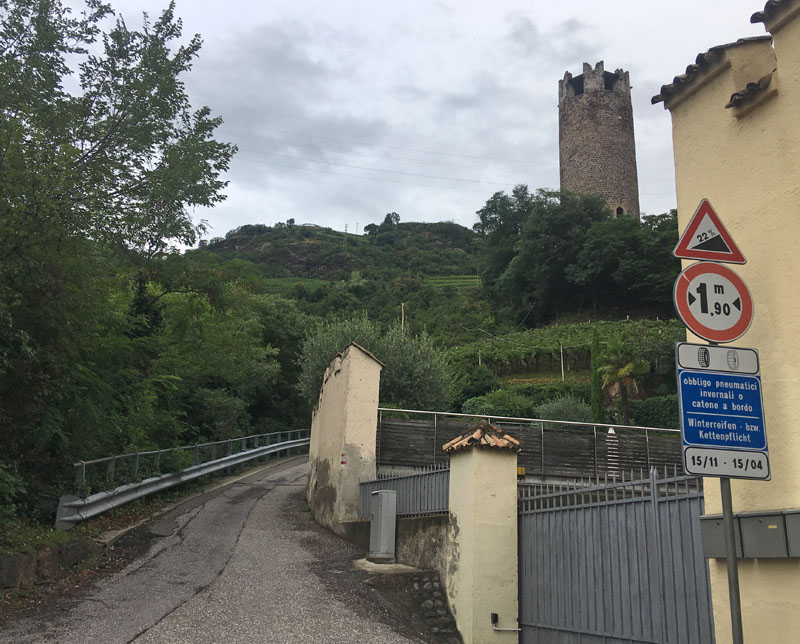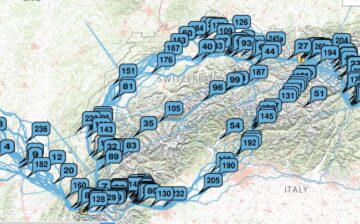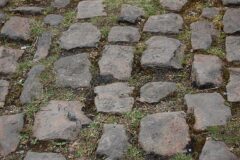This page contains information about the 2019 Transcontinental Race No. 7. See the Overview page for a general introduction to the Transcontinental Race (TCR). See also the official TCR page.
Page Contents:
Route Summary
The race started on the eastern edge of Europe, in Burgas, Bulgaria next to the Black Sea and headed west to Brest, France on the Atlantic Ocean. This was the most dramatic route change in the history of the TCR, with not only the start and finish never having been used before, but also the direction of travel was reversed. The total distance was around 4000 km with about 40,000 meters of climbing.
The first intermediate control point was located in Bulgaria not far from the end of the start parcours and passed the Buzludzha abondoned monument to the communist party. The leaders reached there in under 10 hours. CP2 had 80 km of mostly dirt/gravel roads and a climb up to the peak of Besna Kobila at over 1,900 m elevation in Serbia. Many people reported that the climb was too steep and rough to ride and so they walked most of the upper 2 kms.
CP2 was reached by the leaders in 33.5 hours, making the position more similar to CP1 in other editions of the race. Having an obligatory start parcours and the CP1 parcours on the first day meant that there wasn’t much variety in the early route options.

The CP3 parcours was a long succession of Alpine climbs that started in the Italian Dolomites with the Passo Gardena and went into the Ötztal region of Austria via the Timmelsjoch pass. The control hotel was 110 km further from the Timmelsjoch, on the way up the Arlberg pass. By the time riders reached the CP3 hotel, they had climbed over 8,000 meters of elevation in the previous 300 km. The scenery was fantastic, but most of the riders’ memories were focused on a 2 km-long wall leading out of Bolzano in the middle of the parcours where the first km averaged over 20% and the second was just under 15%. With tired legs, only a handful of riders even attempted to ride up the steepest ramps.
Having the CP3 control hotel well after the long parcours meant that even the leaders took almost 4 days to ride between CP2 and CP3, making it one of the longest gaps in TCR history.
The CP4 parcours in France began by climbing the iconic Col du Galibier from the north, which at 2,642 m elevation was the race’s highest point. The parcours then continued to Alpe d’Huez via a little-known dirt road before descending the classic climb and finishing with a dramatic ‘balcony road’ on the opposite side of the Oisans valley.
The finish was in Brest, a couple of weeks before the Paris-Brest-Paris (PBP) audax race arrived there. PBP is 1200 km long and is the most historic ultra-distance cycling race/event, having first been held in 1891 and is now held only once every 4 years. The 80 km-long finish parcours paid homage to the race by following part of the PBP route.
Here is the simplified map of the 2019 TCR. The route that each rider took can be seen on TrackLeaders.
The length and number of obligatory parcours sections was far greater than in any previous edition. The lengths of the 6 obligatory sections are as follows, each time followed in brackets by the length that was necessary to get to the control hotel or in/out of the region: Start = 145 km (160 km), CP1 = 155 (175), CP2 = 80 (90), CP3 = 165 (285), CP4 = 115 (145), and Finish = 80 (80). In addition, for the short 100 km between the start parcours and CP1 not many people deviated from the obvious, main road.
That gives a total of over 1000 km of obligatory parcours and sections where there were almost no alternative route options, or approximately one quarter of the race distance. Some participants and dot-watchers commented that this gave the race quite a different feel compared to previous editions, where participants had been given a lot more freedom in their route choices between much shorter sections of required parcours.
Results Highlights
Early Leaders
Björn Lenhard was one of the pre-race favorites because he had led for long sections of the previous two TCRs before finishing on the podium each time. Jonathan Rankin was one of the first 10 finishers the previous year, but he had started in a pair and then been delayed when his partner got sick and they had to decide whether to split up, his pace after that suggested that he would be a serious contender.
Björn and Jonathan started strongly, reaching both CP1 and CP2 in 1st and 2nd places, respectively. Unfortunately, Björn had to scratch shortly after leaving the CP2 hotel due to intolerable saddle sores, a problem that he said had started during training.
Fiona Kolbinger
After CP2, during the second night, Fiona Kolbinger, a first-time racer, briefly moved into the race lead while the other front-runners were sleeping. A few hours later she herself stopped to rest and Jonathan Rankin re-took the lead with Ben Davies not far behind. Ben Davies was a two-time veteran who had finished in the top 10 the previous year.
Kosma Szafraniak had arrived at CP2 in 3rd, but he dropped down the leaderboard, with the 19th best time from CP2-3, where he arrived in 10th, but he had to scratch after CP4. There is no tracker data from him for the period just after CP2, so it’s unclear exactly where he was or when he slowed down.
By the morning of the fifth day of racing, the top 3 of Jonathan, Fiona and Ben had established an advantage over the rest and they spent a tense couple of hours less than 10 km apart while passing near Klangenfurt and Villach in SE Austria. By the end of that morning, Jonathan sadly had to pull out of the race due to severe foot problems, which left Fiona in the lead and she was starting to increase her advantage over Ben.
Fiona had the best time from CP2 to CP3 and extended her lead over Ben from 30 minutes at CP2 to 4 hours at CP3, and again had the fastest time between CP3 and 4, further extending the lead to 7 hours. She finished in just under 10 days 3 hours, with a 10-hour advantage over Ben, but that was reduced to under 8 hours with penalties.
The Fight for the Top 5
Sam Thomas had arrived at CP2 in 14th and then moved up to 3rd at CP3 with the 3rd best time for CP2-3. Apparently that push took a lot out of him because his time from CP3-4 was only 90th best of the 112, which dropped him out of the top 10 and he finished in 13th place after penalties.
Pawel Pulawski was 4th to CP3 and was the first person to choose to head back down the Arlberg pass after getting his stamp at CP3 to ride via Italy instead of Switzerland to reach the CP4 parcours (see the Route Choice section below). His segment time to CP4 was relatively slow, so it may not have been the best decision and he arrived there in 7th. Unfortunately, Pawel crashed while on a bike path soon after CP4, which ended his race. He would come back in the next edition (delayed until 2022) to take 3rd place.
Job Hendrix profited from Sam and Pawel making slow progress and moved up from 5th at CP3 to 3rd at CP4. Job said that he hadn’t being paying attention to what anyone else was doing before CP3 and it wasn’t until CP4 that he decided to really start racing at full-speed to see how much time he could make up. He was 15.5 hours behind Ben in 2nd place at CP4 but put in the best time between there and the finish of 56 hours, 13 hours faster than Ben and 10 hours faster than Fiona but he remained in 3rd.
David Schuster had a very consistent race, always in the top 6 at each checkpoint and finished 4th.
Danny Green made the biggest improvement of those who finished in the top 10, having been 32nd at CP2, 14th at CP3 and 12th at CP4. He then had the 2nd best time for CP4 to the Finish and reached there in 8th place but had several hours less penalties than the 3 riders ahead of him, so was officially classified in 5th place, just ahead of Chris Thomas.
Penalties
Only 13 of the 96 solo riders in the GC received no penalties. The others received a total of between 15 minutes and 8 hours 35 minutes of penalties. Danny Cassidy was the first racer to reach the finish and not receive any penalties, which moved him from 14th to 12th position.
It can be assumed that nearly all penalties were given for riding on illegal roads or for missing small sections of a required parcours but this information is not publicly available.
Four riders who reached the finish before the time limit for a GC finish were not included in the GC due to rule violations but were still awarded a Finish. 35 other riders reached the finish after the GC time limit, so were also awarded a Finish. One rider who reached the finish was excluded/disqualified for a major breach of motorway use, as was another rider who scratched before CP2.
Pairs and Females
The first pair was Emanuel Verde & Espen Utne Landgraff, who finished in about 13.5 days, after 62 solo riders had finished. They had been the 1st pair at CP1, but were 2nd at CP2, 3, and 4, then re-took the lead in the final stretch, finishing with a lead of over 18 hours.
18 pairs started the race, 6 reached the finish before the time limit for the GC, but one of those had an infraction that caused them to only be classified as a Finisher and not included in the GC. 3 other pairs reached the finish after the time limit. 6 pairs scratched and 2 pairs ended with one rider having scratched and one rider who continued and finished solo, but outside the time limit.
31 solo females started, only 9 of whom scratched. 10 finished in the GC and 12 finished but outside the time limit. Fiona was the 1st female at every control point. Tanja Hacker, an experienced ultra-distance racer, was the 2nd female at every control point, and finished 22nd overall. Gail Brown was the 3rd female, in 28th place.
Scratch Rate
About 61% of the 222 solo starters reached the finish and 39% (86) scratched, which is a reasonably typical rate for the TCR.
It was interesting to assess the scratch rates at different periods of the race because this was the first time that the race was run from east to west. It had been observed that far fewer people scratched in the second half of previous editions than in the first half.
Many people had assumed that this pattern of scratches was partly due to how much easier it is to scratch in western Europe and find an alternative way home. Once into the second half of the race in eastern Europe, travel logistics and distances become much more challenging, and the easier option is often to stick to the original plan and continue riding to the finish.
The reversed direction of TCR No. 7 provided a good test of this theory. In the end, the same pattern was observed in TCR No. 7 as in previous editions. CP3 was approximately the halfway point of the race in terms of ride time and of the 86 solo riders who scratched, 78 of them did so before CP3 (including 35 before CP2). In addition, 5 of the 6 pairs who scratched did so before CP3.
Differences in travel logistics is therefore not the reason for the pattern of scratches previously observed. It appears that the only reason for this pattern is that by around halfway, most physical problems that are going to develop will have already started and it would also be obvious by then whether someone can maintain their planned rate of progress. Scratch decisions seem to be based more on these two aspects than on how easy it is to find an alternative means of transport home.
Route Choices
As mentioned above, the locations and lengths of the obligatory parcours caused there to be limited variety in route choices for a large part of the race. However, this was not the case for the section between CP3 in Austria and CP4 in France.

Most of the faster riders went via Switzerland and around the northern edge of Lake Geneva, which could be quite flat if the route was well-chosen. However, many of the mid-pack riders chose to go up the Inn valley, over the Maloja Pass into Italy, along Lake Como, through Torino and then over the Col de Mont Cenis into France.
The distance and climbing for these two options were quite similar even though they were extremely different geographically. In previous editions, the region around the Italian Ticino and Po valleys had been reported to contain many dangerous roads that are too narrow for the volume of traffic that they carry during the day, so the organizers had hoped that more people would choose the Swiss option.
A few riders chose to be more adventurous in this section and sought out extra mountains. About a dozen people chose the shortest, but far more mountainous route through Switzerland up the Rhine valley and down the Rhone, going over the 2000+ m high Oberalp and Furka Passes in between, then over some lower passes near the French border.
Three extremely adventurous souls decided to start with the Italian route but instead of using the Col de Mont Cenis, they crossed into France using the Col des Rochilles between Bardonecchia and the start of the CP4 parcours in Valloire. It was actually a shorter route with less climbing than Mont Cenis, but they had to walk for 1-2 hours on the rough hiking path up to the col. No-one was very surprised that it was Mikko Mäkipää who was the first to use this option because he has completed every TCR and is famous for his unconventional route choices.
Media Coverage
The TCR organizers produced regular text and audio reports during the race, see the links below, but this time no official videos were made.
There were 6 official podcasts covering the race:
- TCR No7: The Race Begins
- TCR No7: Beating Sun and a Balkan Wedding
- TCR No7: Climbing Out of the Slump
- TCR No7: TCR No7: The Race Rolls On
- TCR No7: A Finish Not an Ending
- TCR No7: Fiona Kolbinger Interview
And 16 blog posts:
- Pre-race rider photos and some short profiles
- Day 0
- Day 1
- Day 2
- Day 3: On a race as chaotic as the TCR, it pays to keep things simple – so first things first
- Day 4: The sweet science
- Day 5: Intro the mountains, above the clouds
- Day 6: Before the elastic snaps
- Day 7: In the pack
- Day 8
- Day 9: Trials and tribulations
- Day 10: Heartbreak hotel
- Day 11: First one home
- Day 12: Local heroes
- Day 13: Vous êtes des assissins! Oui, des assassins!
- Day 14
- Final report
Apidura’s Dotwatcher.cc website also published regular race updates, and Fizik published several reports: 1, 2, 3, 4, and 5.
Once it was clear that a woman was going to win the race, mainstream media suddenly became interested, which is something that the race had never really received before. The story made the front page of major news networks including the BBC, CNN and France 24. Major British newspapers also ran articles, including The Telegraph and The Guardian. There were many articles in other countries and languages, including France’s l’Equipe; do a Google search to find many more from all over the world.
Follow-up articles by road.cc covered Who is Fiona Kolbinger? and Apidura documented her Race-winning kit. The BBC also used the media interest to address the question of Are women better ultra-endurance athletes than men?.
Fiona was briefly interviewed on BBC Radio 4, skip forward to 2:42:00 of this recording, but her most extensive interview was in the final official TCR podcast.
The organizers posted a video on Twitter during the race showing Fiona playing a piano at Control Point 4 in France. The fact that the race leader felt that she had time to do that and also the energy and manual dexterity after more than a week on the bike surprised many people.
Fiona Kolbinger, leader of #TCRNo7 and…pianist!#TCRNo7cap66 pic.twitter.com/NEwaRtJLWC
— The Transcontinental (@transconrace) August 3, 2019
There were no other official videos, but France 24 made a short unofficial video that’s mostly a collection of images with some French text added.
Doug Migden gave a general summary of what it was like competing in five editions of the race from 2015 to 2019 on the Dotwatcher website.
Last significant page update: February, 2023
This page is in the The Transcontinental Race section. The next page in this section is:

